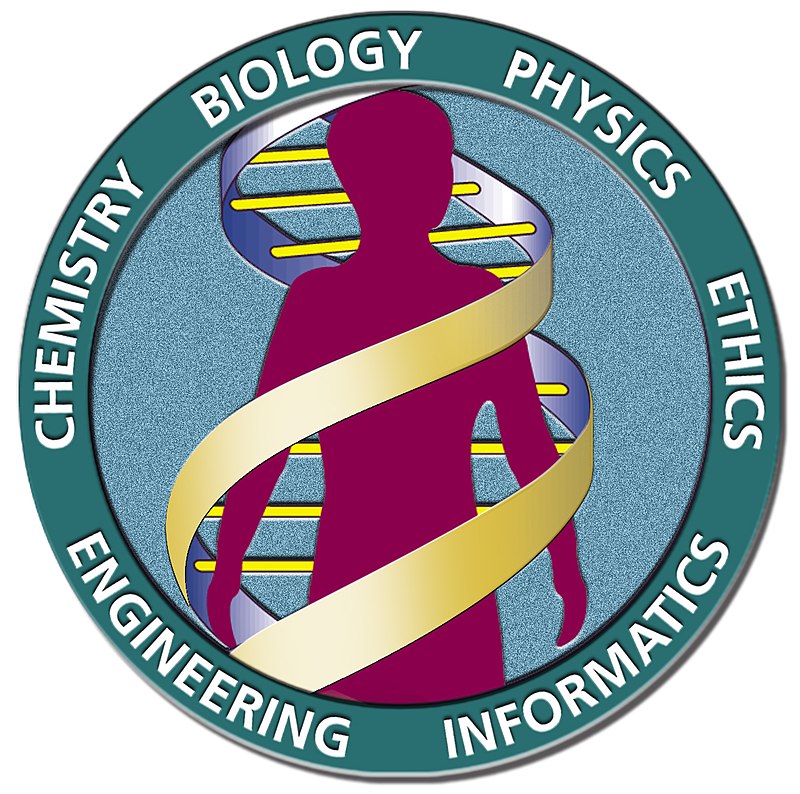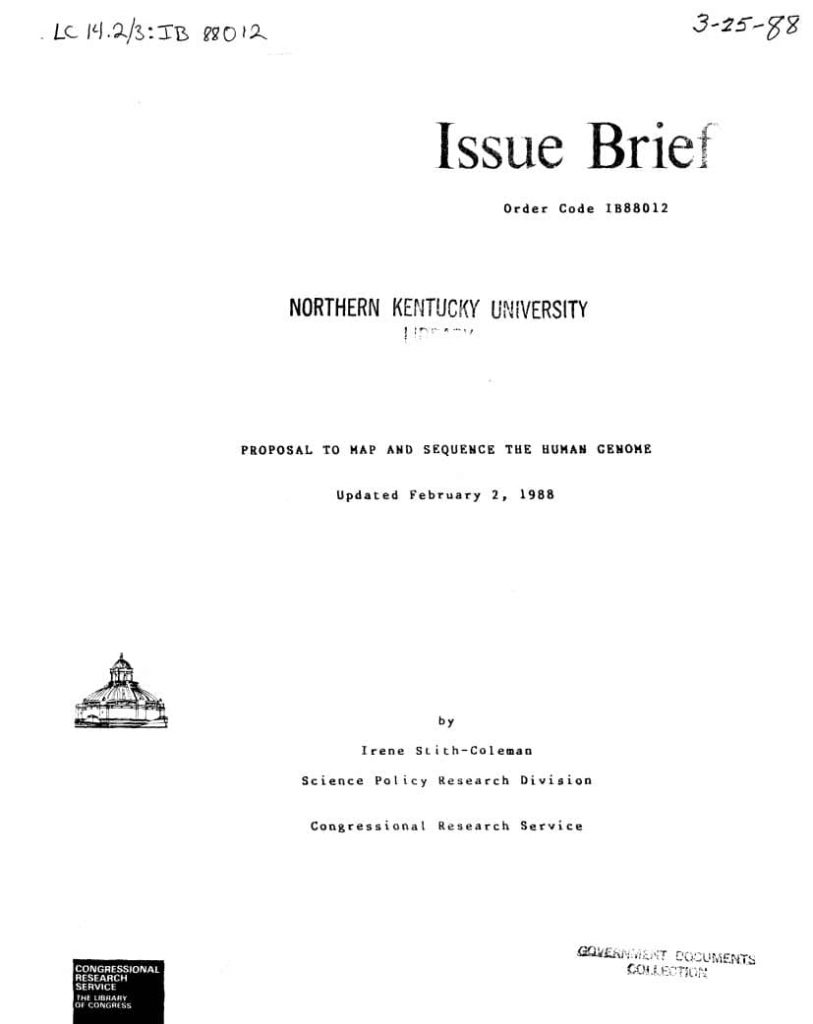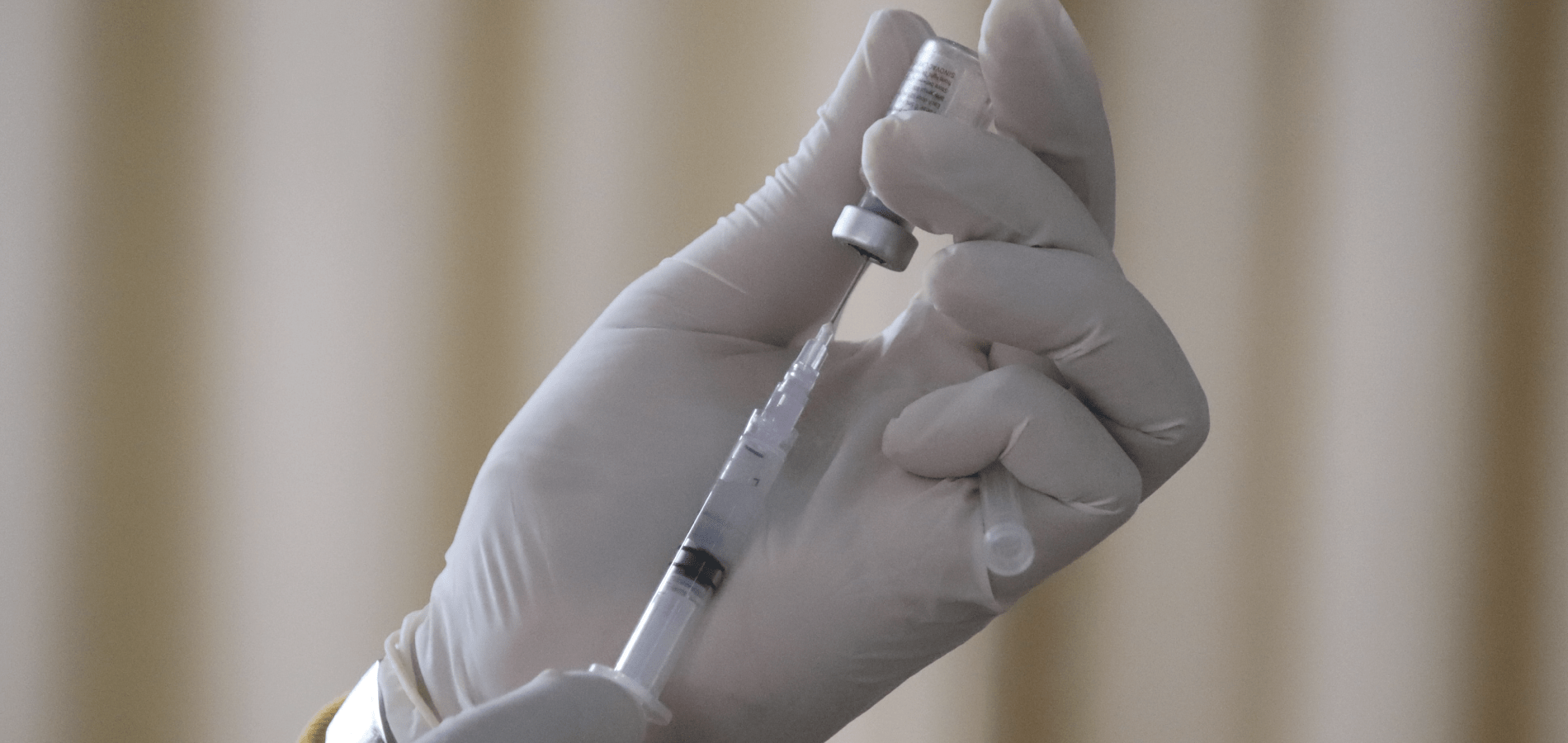Occasionally, the scientific community undertakes a task that is so large and so important that it requires an international effort.[1][i] (1990) ROLE OF INTERNATIONAL COOPERATION IN MAPPING THE HUMAN GENOME. This document can be found in HeinOnline’s U.S. Congressional Documents database. Developing a vaccine for the COVID-19 virus was one of them. The creation of the International Space Station was another. Yet another was the Human Genome Project—an effort to identify and sequence all of the 3 billion base pairs that make up human DNA. The results of this project, which took 13 years and nearly $3 billion, have been essential for learning more about diseases such as cancer and the nature of evolution. However, did you know that this project was initiated by the U.S. Department of Energy and the National Institutes of Health?[2]III (1988) Workshop on Human Gene Mapping. This document can be found in HeinOnline’s U.S. Congressional Documents database. Let’s use HeinOnline to dive into this incredible international effort.

Early Beginnings
Genetic research that led to the development of the Human Genome Project began with Watson and Francis Crick’s discovery of the double-helical structure of DNA in 1953 (thanks to the help of Rosalind Franklin‘s[3]Theresa Esquerra, Exploration of Common Law Fraud in Scientific Discovery: The Case of James Watson, Francis Crick, and Rosalind Franklin, 4 LANDSLIDE 34 (2012). This article can be found in HeinOnline’s Law Journal Library. DNA photography) and continued with further research determining that DNA sequences were made up of four nucleotides—adenine (A), thymine (T), guanine (G), and cytosine (C)[4]Randi B. Weiss , G. Criston Windham, Patricia G. Scales & Brandy K. Gillenwater, The Use of Genetic Testing in the Courtroom, 34 WAKE FOREST L. REV. 889 (1999). This article can be found in HeinOnline’s … Continue reading—that bond together and form base pairs. Scientists quickly started working on determining the order of the pairs. In 1984, Chancellor of the University of Santa Cruz Robert Sinsheimer[5]Robert Mullan Cook-Deegan, Origins of the Human Genome Project, 5 RISK 97 (1994). This article can be found in HeinOnline’s Law Journal Library. worked to gather a group of scientists to discuss the possibility of a human genome sequencing project. Two other scientists, Renato Dulbecco of the Salk Institute and Charles DeLisi from the Department of Energy, were working on their own ideas on how to sequence the human genome. DeLisi,[6]Robert Mullan Cook-Deegan, Origins of the Human Genome Project, 5 RISK 97 (1994). This article can be found in HeinOnline’s Law Journal Library. motivated by his research into mutations among children exposed to atomic bombs, was the driving force behind the proposal that would lead to the inception of the Human Genome Project. The DOE Office of Health and Environmental Research hosted genome sequencing workshops[7]III (1988) Workshop on Human Gene Mapping. This document can be found in HeinOnline’s U.S. Congressional Documents database. to determine whether mapping the entire human genome would be possible. In 1987, the Department of Energy National Laboratory Cooperative Research Initiatives Act[8]312 (1988) Department of Energy National Laboratory Cooperative Research Initiatives Act : hearings before the Subcommittee on Energy Research and Development of the Committee on Energy and Natural Resources, United States Senate, One Hundredth … Continue reading was introduced in Congress to coordinate collaboration between DOE National Laboratories and universities and private firms—this bill also addressed research on the human genome.
Early plans for an international human genome project were formulated in 1988 with the leadership of the National Institutes of Health’s director James Wyngaarden.[9]206 (1998) The human genome project : how private sector developments affect the government program : hearing before the Subcommittee on Energy and Environment of the Committee on Science, U.S. House of Representatives, One Hundred Fifth Congress, … Continue reading The National Center for Human Genome Research was established in 1989, and its first director was, fittingly, James Watson. In April 1990, a five-year plan[10]191 (2001) The Human Genome Project : hearing before the Subcommittee on Energy and Environment of the Committee on Science, House of Representatives, One Hundred Sixth Congress, second session, April 6, 2000. This document can be found in … Continue reading with expectations for the project were released, and the project officially kicked off on October 1 of that year.

Project Goals
There are 3 billion of base pairs that comprise the DNA in one human alone. It is the order of these pairs that separates different species from each other, and individual organisms from other individual organisms within their species. Human DNA sequences are 99.9% identical,[11]Lori B.; et al. Andrews. Genetics: Ethics, Law and Policy (2). This book can be found in HeinOnlien’s West Academic Casebooks Archive. but it is the differences that can affect a person’s disease risk. The goal of the Human Genome Project was to identify, map, and sequence all of the base pairs that make up human beings, and then store this information in databases for free public use. This information could then be used to understand genetic variations that may indicate predisposition to certain diseases and conditions.
Another component of the project was to explore the ethical, legal, and social implications[12]“HUMAN GENOME PROJECT,” The human genome project : hearing before the Subcommittee on Energy Research and Development of the Committee on Energy and Natural Resources, United States Senate, One Hundred First Congress, second session on … Continue reading (referred to as ELSI) of genetic research, including privacy and confidentiality of personal genetic information, commercialization of genetic testing, and the creation of educational materials regarding genetic research.
Building the Genome
In order to create the genome, researchers collected a variety of blood and sperm samples. Only a few of these were processed, but neither donors nor scientists know the identities of the people whose DNA samples were used. However, interestingly, we do know that much of the reference genome sequence came from a male from HeinOnline’s hometown of Buffalo, New York—the DNA reference number was RPCI-11, which stands for Buffalo’s Roswell Park Comprehensive Cancer Center, formerly Roswell Park Cancer Institute.
Building the genome required efforts around the globe. Research was performed in 20 universities and research centers in the United States, the United Kingdom, France, Germany, China, and Japan.[13]354 (2001) The Human Genome Project : hearing before the Subcommittee on Energy and Environment of the Committee on Science, House of Representatives, One Hundred Sixth Congress, second session, April 6, 2000. This document can be found in … Continue reading The process included gene mapping, which was a technique that had been developed through breast cancer research, and DNA sequencing. Although the project was estimated to take 15 years, a rough draft was already finished by 2000 and announced to the public by President Bill Clinton[14]William J. Clinton, Remarks on the Completion of the First Survey of the Human Genome – June 26, 2000, 2000 Pub. Papers 1267 (2000). This document can be found in HeinOnline’s U.S. Presidential Library. and British Prime Minister Tony Blair on June 26 of that year. A 92% complete genome was then announced on August 14, 2003, two years earlier than expected. While considered complete in 2003,[15]George W. Bush, Joint Proclamation by the Heads of Government of Six Countries Regarding the Completion of the Human Genome Sequence – April 14, 2003, 2003 Pub. Papers 342 (2003). This document can be found in HeinOnline’s U.S. … Continue reading, efforts persisted to achieve 100% completion with 99.99% accuracy, goals which were finally attained in January 2022.
Today, we are learning the language in which God created life. We are gaining ever more awe for the complexity, the beauty, the wonder of God’s most divine and sacred gift. With this profound new knowledge, humankind is on the verge of gaining immense new power to heal. Genome science will have a real impact on all our lives and even more on the lives of our children.
Impacts of the Project
Because of the Human Genome Project, scientists have been able to create genetic tests that can reveal predispositions to a variety of illnesses, such as cancer and cystic fibrosis. However, this testing led to the fear that employers and insurance companies could use this information to discriminate against those who have a higher likelihood of developing a disease. The Health Insurance Portability and Accountability Act (HIPAA), which passed in 1996, outlaws unauthorized release of an individual’s medical information and does not allow genetic information to be considered a preexisting condition.
Additionally, scientists have been able to use this information to research genomes for other species,[16]Lori B.; et al. Andrews. Genetics: Ethics, Law and Policy (2). This book can be found in HeinOnlien’s West Academic Casebooks Archive. such as mice. Further human genome research is continuing through projects like the Human Pangenome Project, which strives to build human genomes that represent a wider diversity of people.

Further Reading in HeinOnline
Interested in learning more about the Human Genome Project? Take a look at these articles that you can find in HeinOnline’s Law Journal Library!
- Origins of the Human Genome Project
- Reproductive Rights and the Human Genome Project
- The Human Genome Project: A Public Good
- The Human Genome Project and Human Identity
- The Human Genome Project – Promise and Problems
And be sure to subscribe to the HeinOnline Blog so that you get blog posts on history, politics, current events, true crime, database news and updates, and much more delivered right to your inbox!
HeinOnline Sources[+]
| ↑1 | [i] (1990) ROLE OF INTERNATIONAL COOPERATION IN MAPPING THE HUMAN GENOME. This document can be found in HeinOnline’s U.S. Congressional Documents database. |
|---|---|
| ↑2, ↑7 | III (1988) Workshop on Human Gene Mapping. This document can be found in HeinOnline’s U.S. Congressional Documents database. |
| ↑3 | Theresa Esquerra, Exploration of Common Law Fraud in Scientific Discovery: The Case of James Watson, Francis Crick, and Rosalind Franklin, 4 LANDSLIDE 34 (2012). This article can be found in HeinOnline’s Law Journal Library. |
| ↑4 | Randi B. Weiss , G. Criston Windham, Patricia G. Scales & Brandy K. Gillenwater, The Use of Genetic Testing in the Courtroom, 34 WAKE FOREST L. REV. 889 (1999). This article can be found in HeinOnline’s Law Journal Library. |
| ↑5, ↑6 | Robert Mullan Cook-Deegan, Origins of the Human Genome Project, 5 RISK 97 (1994). This article can be found in HeinOnline’s Law Journal Library. |
| ↑8 | 312 (1988) Department of Energy National Laboratory Cooperative Research Initiatives Act : hearings before the Subcommittee on Energy Research and Development of the Committee on Energy and Natural Resources, United States Senate, One Hundredth Congress, first session on S. 1480 … September 15 and 17, 1987. Part 1. This document can be found in HeinOnline’s U.S. Congressional Documents database. |
| ↑9 | 206 (1998) The human genome project : how private sector developments affect the government program : hearing before the Subcommittee on Energy and Environment of the Committee on Science, U.S. House of Representatives, One Hundred Fifth Congress, second session, June 17, 1998. This document can be found in HeinOnline’s U.S. Congressional Documents database. |
| ↑10 | 191 (2001) The Human Genome Project : hearing before the Subcommittee on Energy and Environment of the Committee on Science, House of Representatives, One Hundred Sixth Congress, second session, April 6, 2000. This document can be found in HeinOnline’s U.S. Congressional Documents database. |
| ↑11, ↑16 | Lori B.; et al. Andrews. Genetics: Ethics, Law and Policy (2). This book can be found in HeinOnlien’s West Academic Casebooks Archive. |
| ↑12 | “HUMAN GENOME PROJECT,” The human genome project : hearing before the Subcommittee on Energy Research and Development of the Committee on Energy and Natural Resources, United States Senate, One Hundred First Congress, second session on the human genome project, July 11, 1990. (1990): I-202. This document can be found in HeinOnline’s U.S. Congressional Documents database. |
| ↑13 | 354 (2001) The Human Genome Project : hearing before the Subcommittee on Energy and Environment of the Committee on Science, House of Representatives, One Hundred Sixth Congress, second session, April 6, 2000. This document can be found in HeinOnline’s U.S. Congressional Documents database. |
| ↑14 | William J. Clinton, Remarks on the Completion of the First Survey of the Human Genome – June 26, 2000, 2000 Pub. Papers 1267 (2000). This document can be found in HeinOnline’s U.S. Presidential Library. |
| ↑15 | George W. Bush, Joint Proclamation by the Heads of Government of Six Countries Regarding the Completion of the Human Genome Sequence – April 14, 2003, 2003 Pub. Papers 342 (2003). This document can be found in HeinOnline’s U.S. Presidential Library. |



